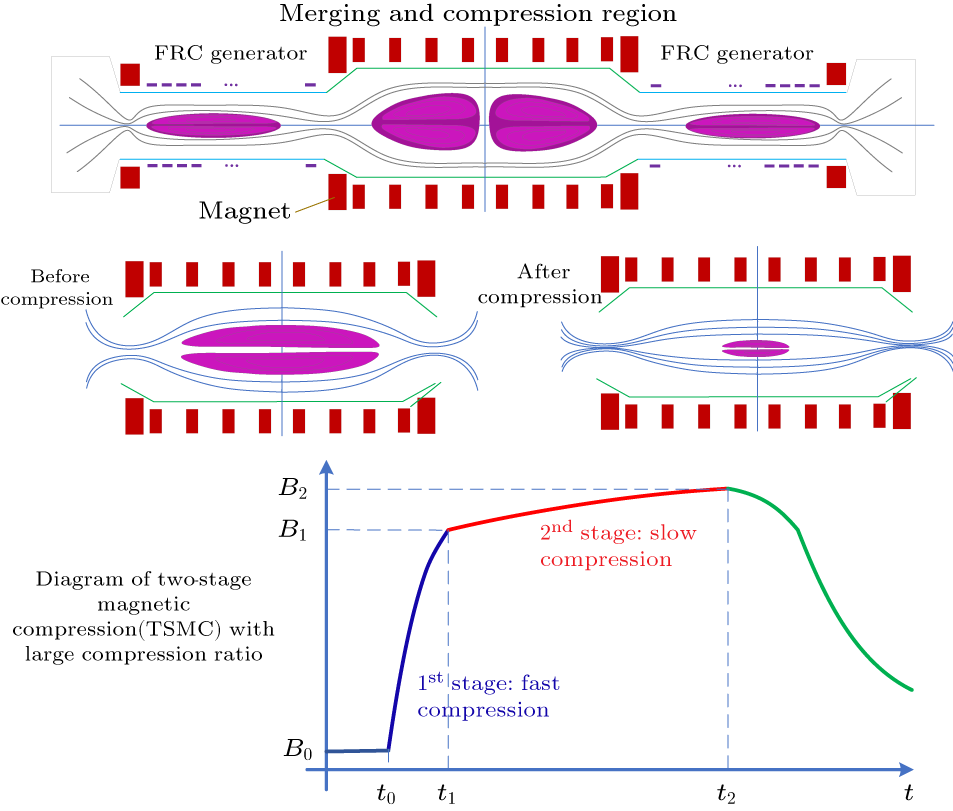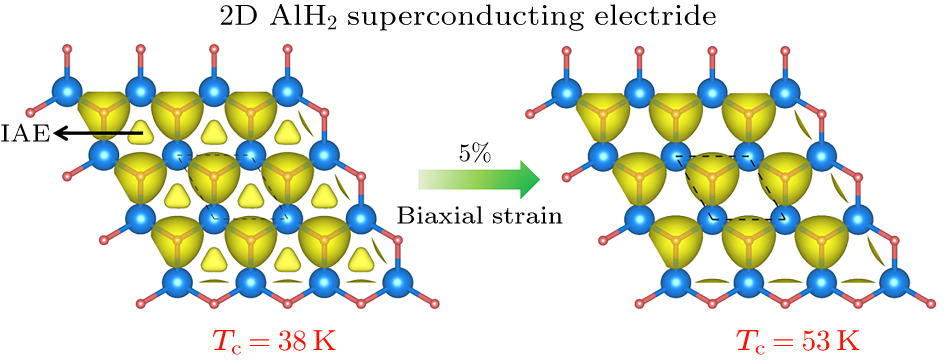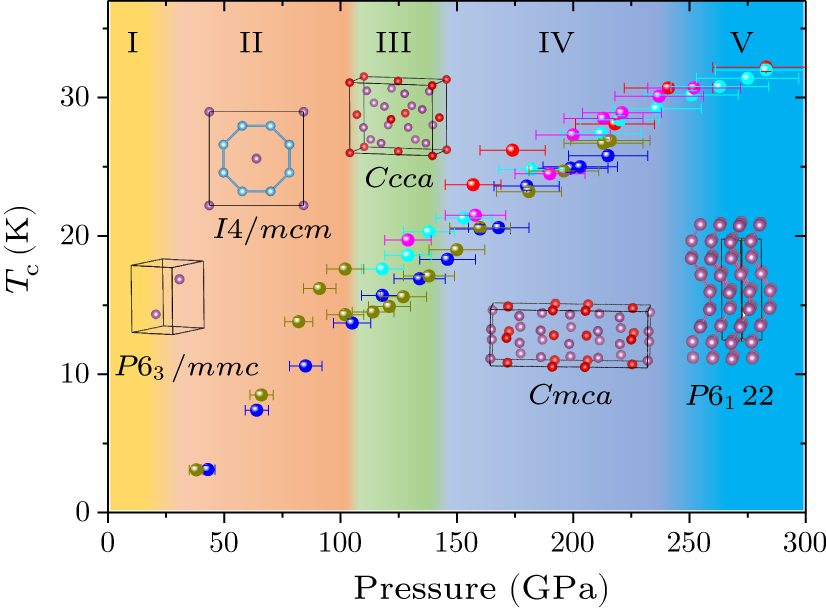Select
Quantum Brayton Refrigeration Cycle with Finite-Size Bose–Einstein Condensates
Jiehong Yuan, Huilin Ruan, Dehua Liu, Jizhou He, and Jianhui Wang
Chin. Phys. Lett. 2023, 40 (10 ):
100502
.
DOI: 10.1088/0256-307X/40/10/100502
We consider a quantum Brayton refrigeration cycle consisting of two isobaric and two adiabatic processes, using an ideal Bose gas of finite particles confined in a harmonic trap as its working substance. Quite generally, such a machine falls into three different cases, classified as the condensed region, non-condensed phase, and regime across the critical point. When the refrigerator works near the critical region, both figure of merit and cooling load are significantly improved due to the singular behavior of the specific heat, and the coefficient of performance at maximum figure of merit is much larger than the Curzon–Ahlborn value. With the machine in the non-condensed regime, the coefficient of performance for maximum figure of merit agrees well with the Curzon–Ahlborn value.
Select
A Quorum Sensing Active Matter in a Confined Geometry
Yuxin Zhou, Yunyun Li, and Fabio Marchesoni
Chin. Phys. Lett. 2023, 40 (10 ):
100505
.
DOI: 10.1088/0256-307X/40/10/100505
Inspired by the problem of biofilm growth, we numerically investigate clustering in a two-dimensional suspension of active (Janus) particles of finite size confined in a circular cavity. Their dynamics is regulated by a non-reciprocal mechanism that causes them to switch from active to passive above a certain threshold of the perceived near-neighbor density (quorum sensing ). A variety of cluster phases, i.e., glassy, solid (hexatic) and liquid, are observed, depending on the particle dynamics at the boundary, the quorum sensing range, and the level of noise.
Select
A New Device Concept of Magnetic Confinement Deuterium–Deuterium Fusion
Yuan Pan, Songtao Wu, Zhijiang Wang, Zhipeng Chen, Min Xu, Bo Rao, Ping Zhu, Yong Yang, Ming Zhang, Yonghua Ding, and Donghui Xia
Chin. Phys. Lett. 2023, 40 (10 ):
102801
.
DOI: 10.1088/0256-307X/40/10/102801
A two-stage cascade magnetic compression scheme based on field reversed configuration plasma is proposed. The temperature and density of plasma before and after magnetic compression are analyzed. In addition, the suppression of the two-fluid effect and the finite Larmor radius effect on the tilting mode and the rotating mode of major magnetic hydrodynamic instability is studied, and finally, the key physical and engineering parameters of the deuterium–deuterium fusion pulse device are introduced. Further analysis shows that the fusion neutrons can be produced at an energy flux of more than 2 MW/m$^{2}$ per year, which meets the material testing requirements for the fusion demonstration reactor (DEMO). If the recovery of magnetic field energy is taken into account, net energy outputs may be achieved, indicating that the scheme has a potential application prospect as a deuterium–deuterium pulse fusion energy.
Select
Wavelength Dependence of Atomic Excitation for Ar Subject to Intense Midinfrared Laser Pulses
Yang-Ni Liu, Song-Po Xu, Mu-Feng Zhu, Zheng-Rong Xiao, Shao-Gang Yu, Lin-Qiang Hua, Xuan-Yang Lai, Wei Quan, Wen-Xing Yang, and Xiao-Jun Liu
Chin. Phys. Lett. 2023, 40 (10 ):
103201
.
DOI: 10.1088/0256-307X/40/10/103201
We report experimental and theoretical investigations of wavelength dependence of Rydberg state excitation (RSE) process of Ar subject to intense laser fields. By simultaneously measuring ionization and RSE yields of Ar atoms subject to strong laser fields at a series of wavelengths, we obtain the wavelength scaling law of the ratio of Ar$^{*}$ over Ar$^{+}$ with respect to the laser intensity, and this result can be well reproduced by a nonadiabatic model, but not by the classical-trajectory Monte Carlo model. Our results indicate that the nonadiabatic corrections of the photoelectron tunneling exit and tunneling probability play a significant role at shorter wavelengths. Analysis shows that the wavelength dependence phenomenon is due to the interplay of the nonadiabatic effect, wave-packet diffusion and Coulomb focusing effect of the liberated electron.
Select
Multifunctional Composite Material with Efficient Microwave Absorption and Ultra-High Thermal Conductivity
Yun Wang, Tian-Cheng Han, Di-Fei Liang, and Long-Jiang Deng
Chin. Phys. Lett. 2023, 40 (10 ):
104101
.
DOI: 10.1088/0256-307X/40/10/104101
The increasing demands for electronic devices to achieve high miniaturization, functional integration, and wide bandwidth will exacerbate the heat generation and electromagnetic interference, which hinders the further development of electronic devices. Therefore, both the issues of microwave absorption and heat dissipation of materials need to be addressed simultaneously. Herein, a multifunctional composite material is proposed by periodic arrangement of copper pillars in a matrix, based on the wave-absorbing material. As a result, the equivalent thermal conductivity of the composite structure is nearly 35 times higher than the wave-absorbing matrix, with the area filling proportion of the thermal conductivity material being 3.14%. Meanwhile, the reflectivity of the composite structure merely changes from $-15.05$ dB to $-13.70$ dB. It is proved that the designed composite structure possesses both high thermal conduction and strong microwave absorption. The measured results accord well with the simulation results, which demonstrates that the thermal conductivity of the composite structure can reach more than 10 W$\cdot$m$^{-1}\cdot$K$^{-1}$ without significant deterioration of the absorption performance.
Select
Nonreciprocal Phonon Laser in an Asymmetric Cavity with an Atomic Ensemble
Kai-Wei Huang, Xin Wang, Qing-Yang Qiu, Long Wu, and Hao Xiong
Chin. Phys. Lett. 2023, 40 (10 ):
104201
.
DOI: 10.1088/0256-307X/40/10/104201
Phonon lasers, as a novel kind of lasers for generating coherent sound oscillation, has attracted extensive attention. Here, we theoretically propose a nonreciprocal phonon laser in a hybrid optomechanical system, which is composed of an asymmetric Fabry–Pérot cavity, an ensemble of $N$ identical two-level atoms, and a mechanical oscillator. The effective driving amplitude related to driving direction leads to an obvious difference in mechanical gain and threshold power, bringing about a nonreciprocal phonon laser. In addition, the dependence of the phonon laser on the atomic parameters is also discussed, including the decay rate of the atoms and the coupling strength between the atoms and the cavity field, which provides an additional degree of freedom to control the phonon laser action. Our work provides a path to realizing a phonon laser in an atoms-cavity optomechanical system and may aid the manufacture of directional coherent phonon sources.
Select
Global Effects on Drift Wave Microturbulence in Tokamak Plasmas
Hui Li, Ji-Quan Li, and Zheng-Xiong Wang
Chin. Phys. Lett. 2023, 40 (10 ):
105201
.
DOI: 10.1088/0256-307X/40/10/105201
Microturbulence excited by ion temperature gradient (ITG)-dominant and trapped electron mode (TEM)-dominant instabilities is investigated by employing an extended fluid code (ExFC) based on the so-called Landau fluid model, which includes the trapped electron dynamics. Firstly, the global effect is emphasized through direct comparison of ITG and TEM instability domains based on local and global simulations. The global effect makes differences in both linear instability and nonlinear transport, including the fluxes and the structure of zonal flow. The transitions among ITG, TEM, and ITG & TEM (ITG & TEM represents that ITG and TEM coexist with different wavelengths) instabilities/turbulence depend not only on the three key drive forces $({R/L_{\rm n}, R/L_{\rm Te}, R/L_{\rm Ti}})$ but also on their global (profile) effects. Secondly, a lot of electrostatic linear gyro-fluid simulations are concluded to obtain a distribution of the instability.
Select
Two-Dimensional Thermal Regulation Based on Non-Hermitian Skin Effect
Qiang-Kai-Lai Huang, Yun-Kai Liu, Pei-Chao Cao, Xue-Feng Zhu, and Ying Li
Chin. Phys. Lett. 2023, 40 (10 ):
106601
.
DOI: 10.1088/0256-307X/40/10/106601
The non-Hermitian skin effect has been applied in multiple fields. However, there are relatively few models in the field of thermal diffusion that utilize the non-Hermitian skin effect for achieving thermal regulation. Here, we propose two non-Hermitian Su–Schrieffer–Heeger (SSH) models for thermal regulation: one capable of achieving edge states, and the other capable of achieving corner states within the thermal field. By analyzing the energy band structures and the generalized Brillouin zone, we predict the appearance of the non-Hermitian skin effect in these two models. Furthermore, we analyze the time-dependent evolution results and assess the robustness of the models. The results indicate that the localized thermal effects of the models align with our predictions. In a word, this work presents two models based on the non-Hermitian skin effect for regulating the thermal field, injecting vitality into the design of non-Hermitian thermal diffusion systems.
Select
Contrasting Transport Performance of Electron- and Hole-Doped Epitaxial Graphene for Quantum Resistance Metrology
Xinyi Wan, Xiaodong Fan, Changwei Zhai, Zhenyu Yang, Lilong Hao, Lin Li, Yunfeng Lu, and Changgan Zeng
Chin. Phys. Lett. 2023, 40 (10 ):
107201
.
DOI: 10.1088/0256-307X/40/10/107201
Epitaxial graphene grown on silicon carbide (SiC/graphene) is a promising solution for achieving a high-precision quantum Hall resistance standard. Previous research mainly focused on the quantum resistance metrology of n-type SiC/graphene, while a comprehensive understanding of the quantum resistance metrology behavior of graphene with different doping types is lacking. Here, we fabricated both n- and p-type SiC/graphene devices via polymer-assisted molecular adsorption and conducted systematic magneto-transport measurements in a wide parameter space of carrier density and temperature. It is demonstrated that n-type devices show greater potential for development of quantum resistance metrology compared with p-type devices, as evidenced by their higher carrier mobility, lower critical magnetic field for entering quantized Hall plateaus, and higher robustness of the quantum Hall effect against thermal degeneration. These discrepancies can be reasonably attributed to the weaker scattering from molecular dopants for n-type devices, which is further supported by the analyses on the quantum interference effect in multiple devices. These results enrich our understanding of the charged impurity on electronic transport performance of graphene and, more importantly, provide a useful reference for future development of graphene-based quantum resistance metrology.
Select
Coexistence of Zero-Dimensional Electride State and Superconductivity in AlH$_{2}$ Monolayer
Qiuping Yang, Xue Jiang, and Jijun Zhao
Chin. Phys. Lett. 2023, 40 (10 ):
107401
.
DOI: 10.1088/0256-307X/40/10/107401
Electrides, which confine “excess anionic electrons” in subnanometer-sized cavities of a lattice, are exotic ionic crystals. We propose a non-stoichiometric strategy to realize intrinsic two-dimensional (2D) superconducting electride. AlH$_{2}$ monolayer, which is structurally identical to 1H-MoS$_{2}$, possesses zero-dimensionally confined anionic electrons in the interstitial sites of Al triangles, corresponding to a chemical formula of [AlH$_{2}$]$^{+}e^{-}$. The interaction between interstitial anionic electrons (IAEs) and host cation lattice mainly accounts for stabilization of 1H-AlH$_{2}$ electride. Impressively, 1H-AlH$_{2}$ monolayer is an intrinsic Bardeen–Cooper–Schrieffer superconductor with $T_{\rm c}=38$ K, which is the direct consequence of strong coupling of the H-dominated high electronic states with Al acoustic branch vibrations and mid-frequency H-derived phonon softening modes caused by Kohn anomalies. Under tensile strain, IAEs transform into itinerant electrons, favoring the formation of stable Cooper pairs. Therefore, $T_{\rm c}$ reaches up to 53 K at a biaxial fracture strain of 5%. Our findings provide valuable insights into the correlation between non-stoichiometric electrides and superconducting microscopic mechanisms at the 2D limit.
Select
Pressure-Induced Superconductivity in the Charge-Density-Wave Compound LaTe$_{2- x}$Sb$_{x}$ ($x = 0$ and 0.4)
Xu Chen, Pei-han Sun, Zhenkai Xie, Fanqi Meng, Cuiying Pei, Yanpeng Qi, Tianping Ying, Kai Liu, Jian-gang Guo, and Xiaolong Chen
Chin. Phys. Lett. 2023, 40 (10 ):
107402
.
DOI: 10.1088/0256-307X/40/10/107402
Magnetic CeTe$_{2}$ achieving superconductivity under external pressure has received considerable attention. The intermingling of 4$f$ and 5$d$ electrons from Ce raised the speculation of an unconventional pairing mechanism arising from magnetic fluctuations. Here, we address this speculation using a nonmagnetic 4$f$-electron-free LaTe$_{2}$ as an example. No structural phase transition can be observed up to 35 GPa in the in situ synchrotron diffraction patterns. Subsequent high-pressure electrical measurements show that LaTe$_{2}$ exhibits superconductivity at 20 Gpa with its $T_{\rm c}$ (4.5 K) being two times higher than its Ce-counterpart. Detailed theoretical calculations reveal that charge transfer from the 4$p$ orbitals of the planar square Te–Te network to the 5$d$ orbitals of La is responsible for the emergence of superconductivity in LaTe$_{2}$, as confirmed by Hall experiments. Furthermore, we study the modulation of $q_{\scriptscriptstyle{\rm CDW}}$ by Sb substitution and find a record high $T_{\rm c}^{\rm onset} \sim 6.5$ K in LaTe$_{1.6}$Sb$_{0.4}$. Our work provides an informative clue to comprehend the role of $5d$–$4p$ hybridization in the relationship between charge density wave (CDW) and superconductivity in these RETe$_{2}$ (RE = rare-earth elements) compounds.
Select
Superconductivity above 30 K Achieved in Dense Scandium
Xin He, Changling Zhang, Zhiwen Li, Sijia Zhang, Shaomin Feng, Jianfa Zhao, Ke Lu, Baosen Min, Yi Peng, Xiancheng Wang, Jin Song, Luhong Wang, Saori I. Kawaguchi, Cheng Ji, Bing Li, Haozhe Liu, J. S. Tse, and Changqing Jin
Chin. Phys. Lett. 2023, 40 (10 ):
107403
.
DOI: 10.1088/0256-307X/40/10/107403
Superconductivity is one of most intriguing quantum phenomena, and the quest for elemental superconductors with high critical temperature ($T_{\rm c}$) is of great scientific significance due to their relatively simple material composition and the underlying mechanism. Here we report the experimental discovery of densely compressed scandium (Sc) becoming the first elemental superconductor with $T_{\rm c}$ breaking into 30 K range, which is comparable to the $T_{\rm c}$ values of the classic La–Ba–Cu–O or LaFeAsO superconductors. Our results show that $T_{\rm c}^{\rm onset}$ of Sc increases from $\sim$ $3$ K at around 43 GPa to $\sim$ $32$ K at about 283 GPa ($T_{\rm c}^{\rm zero} \sim 31$ K), which is well above liquid neon temperature. Interestingly, measured $T_{\rm c}$ shows no sign of saturation up to the maximum pressure achieved in our experiments, indicating that $T_{\rm c}$ may be even higher upon further compression.
20 articles


